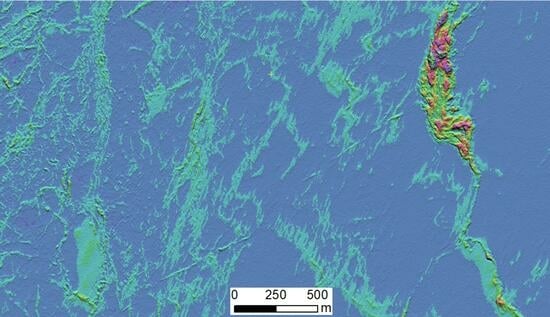Satellite-Based Identification and Characterization of Extreme Ice Features: Hummocks and Ice Islands
Abstract
:1. Introduction
2. Study Area and Data
2.1. Study Areas
2.2. Satellite Data
2.3. Validation Information
3. Methods and Results
3.1. Electro-Optical and Infrared
3.1.1. VHR Data
3.1.2. Stereo-Photogrammetry
3.1.3. Height from Shadow
3.1.4. Landsat 8
Pansharpened Image
Thermal Infrared
- A coarse resolution (100 m);
- Sensitivity to the presence of even small amounts of cloud;
- Missing thermal contrast variation for the ice area at the edge of sea ice and open water;
- Thermal contrast may be caused by other features; in some cases thermal contrast was observed from multiyear floes and land-fast ice features;
- In the summer months, when snow is wet or ice is covered by melt pounds, the thermal band may not generate sufficient contrast for automated detection of thicker features.
3.2. SAR
3.2.1. Single-Pass InSAR
3.2.2. Polarimetry
3.2.3. Height from Shadow
3.2.4. Shape from Shading
3.2.5. Stereo-Radargrammetry
4. Discussion
5. Conclusions
Author Contributions
Funding
Acknowledgments
Conflicts of Interest
References
- Canadian Ice Service Manual of Ice (MANICE). Available online: https://www.canada.ca/en/environment-climate-change/services/weather-manuals-documentation/manice-manual-of-ice.html (accessed on 31 July 2023).
- Melling, H. Thickness of Multi-Year Sea Ice on the Northern Canadian Polar Shelf: A Second Look after 40 Years. Cryosphere 2022, 16, 3181–3197. [Google Scholar] [CrossRef]
- McGonigal, D.; Barrette, P.D. A Field Study of Grounded Ice Features and Associated Seabed Gouging in the Canadian Beaufort Sea. Cold Reg. Sci. Technol. 2018, 146, 142–154. [Google Scholar] [CrossRef]
- McGonigal, D.; Hagen, D.; Guzman, L. Extreme Ice Features Distribution in the Canadian Arctic. In Proceedings of the International Conference on Port and Ocean Engineering Under Arctic Conditions, Montreal, QC, Canada, 10–14 July 2011. [Google Scholar]
- Pilkington, G.; Hill, M.; Metge, M.; McGonigal, D. Beaufort Sea Ice Design Criteria: Acquisition of Data on EIFs [Extreme Ice Features]; Canatec Consultants Ltd.: Calgary, AB, Canada, 1992; p. 154. [Google Scholar]
- Barber, D.G.; McCullough, G.; Babb, D.; Komarov, A.S.; Candlish, L.M.; Lukovich, J.V.; Asplin, M.; Prinsenberg, S.; Dmitrenko, I.; Rysgaard, S. Climate Change and Ice Hazards in the Beaufort Sea. Elem. Sci. Anthr. 2014, 2, 25. [Google Scholar] [CrossRef]
- Galley, R.J.; Else, B.G.T.; Prinsenberg, S.J.; Babb, D.; Barber, D.G. Summer Sea Ice Concentration, Motion, and Thickness Near Areas of Proposed Offshore Oil and Gas Development in the Canadian Beaufort Sea—2009. Arctic 2013, 66, 105–116. [Google Scholar] [CrossRef]
- Bowditch, N. American Practical Navigator, An Epitome of Navigation; Pub. No. 9; National Imaging and Mapping Agency: Bethesda, Maryland, 2002. [Google Scholar]
- Barker, A.; De Abreu, R.; Timco, G.W. Satellite Detection and Monitoring of Sea Ice Rubble Fields. In Proceedings of the 19th IAHR Symposium on Ice, Vancouver, BC, Canada, 6–11 July 2008; Volume 1, pp. 419–430. [Google Scholar]
- Dierking, W.; Dall, J. Sea-Ice Deformation State from Synthetic Aperture Radar Imagery—Part I: Comparison of C-and L-Band and Different Polarization. Geosci. Remote Sens. IEEE Trans. 2007, 45, 3610–3622. [Google Scholar] [CrossRef]
- Zhang, Y.; Touzi, R.; Feng, W.; Hong, G.; Lantz, T.C.; Kokelj, S.V. Landscape-scale Variations in Near-surface Soil Temperature and Active-layer Thickness: Implications for High-resolution Permafrost Mapping. Permafr. Periglac. Process 2021, 32, 627–640. [Google Scholar] [CrossRef]
- Park, S.-E. Variations of Microwave Scattering Properties by Seasonal Freeze/Thaw Transition in the Permafrost Active Layer Observed by ALOS PALSAR Polarimetric Data. Remote Sens. 2015, 7, 17135–17148. [Google Scholar] [CrossRef]
- Usami, N.; Muhuri, A.; Bhattacharya, A.; Hirose, A. Proposal of Wet Snowmapping with Focus on Incident Angle Influential to Depolarization of Surface Scattering. In Proceedings of the 2016 IEEE International Geoscience and Remote Sensing Symposium (IGARSS), Beijing, China, 10–15 July 2016; pp. 1544–1547. [Google Scholar]
- Tsai, Y.-L.S.; Dietz, A.; Oppelt, N.; Kuenzer, C. Remote Sensing of Snow Cover Using Spaceborne SAR: A Review. Remote Sens. 2019, 11, 1456. [Google Scholar] [CrossRef]
- Canatec. Beaufort and Chukchi Seas Design Criteria—Extreme Ice Features and Multi-Year Floe/Ridge Statistics; Canatec Associates International Ltd.: Calgary, AB, Canada, 2010. [Google Scholar]
- Gill, J.; Yackel, J. Evaluation of C-Band SAR Polarimetric Parameters for Discrimination of First-Year Sea Ice Types. Can. J. Remote Sens. 2012, 38, 306–323. [Google Scholar] [CrossRef]
- Zakharov, I.; Bobby, P.; Power, D.; Warren, S. Monitoring Extreme Ice Features Using Multi-Resolution RADARSAT-2 Data. In Proceedings of the Geoscience and Remote Sensing Symposium (IGARSS), 2014 IEEE International, Quebec City, QC, Canada, 13–18 July 2014; pp. 3972–3975. [Google Scholar]
- Leira, B.J.; Chai, W.; Radhakrishnan, G. On Characteristics of Ice Ridges and Icebergs for Design of Ship Hulls in Polar Regions Based on Environmental Design Contours. Appl. Sci. 2021, 11, 5749. [Google Scholar] [CrossRef]
- Mussells, O.; Dawson, J.; Howell, S. Using RADARSAT to Identify Sea Ice Ridges and Their Implications for Shipping in Canada’s Hudson Strait. Arctic 2016, 69, 421–433. [Google Scholar] [CrossRef]
- Duncan, K.; Farrell, S.L. Determining Variability in Arctic Sea Ice Pressure Ridge Topography with ICESat-2. Geophys. Res. Lett. 2022, 49, e2022GL100272. [Google Scholar] [CrossRef]
- Lensu, M.; Similä, M. Ice Ridge Density Signatures in High-Resolution SAR Images. Cryosphere 2022, 16, 4363–4377. [Google Scholar] [CrossRef]
- Power, D.; Youden, J.; Lane, K.; Randell, C.; Flett, D. Iceberg Detection Capabilities of RADARSAT Synthetic Aperture Radar. Can. J. Remote Sens. 2001, 27, 476–486. [Google Scholar] [CrossRef]
- Karvonen, J.; Gegiuc, A.; Niskanen, T.; Montonen, A.; Buus-Hinkler, J.; Rinne, E. Iceberg Detection in Dual-Polarized C-Band SAR Imagery by Segmentation and Nonparametric CFAR (SnP-CFAR). IEEE Trans. Geosci. Remote Sens. 2022, 60, 4300812. [Google Scholar] [CrossRef]
- Haas, C. Airborne Observations of the Distribution, Thickness, and Drift of Different Sea Ice Types and Extreme Ice Features in the Canadian Beaufort Sea. In The All Days; Paper Number OTC-23812; OTC: Houston, TX, USA, 2012. [Google Scholar]
- Dawson, G.; Landy, J.; Tsamados, M.; Komarov, A.S.; Howell, S.; Heorton, H.; Krumpen, T. A 10-Year Record of Arctic Summer Sea Ice Freeboard from CryoSat-2. Remote Sens. Environ. 2022, 268, 112744. [Google Scholar] [CrossRef]
- Tournadre, J.; Bouhier, N.; Girard-Ardhuin, F.; Rémy, F. Large Icebergs Characteristics from Altimeter Waveforms Analysis. J. Geophys. Res. Ocean. 2015, 120, 1954–1974. [Google Scholar] [CrossRef]
- Zakharov, I.; Bobby, P.; Power, D.; Warren, S.; Howell, M. Detection and Characterization of Extreme Ice Features in Single High Resolution Satellite Imagery. In Proceedings of the 2014 IEEE Geoscience and Remote Sensing Symposium, Quebec City, QC, Canada, 13–18 July 2014; pp. 3965–3968. [Google Scholar]
- Dierking, W.; Lang, O.; Busche, T. Sea Ice Local Surface Topography from Single-Pass Satellite InSAR Measurements: A Feasibility Study. Cryosphere 2017, 11, 1967–1985. [Google Scholar] [CrossRef]
- Dammann, D.O.; Eriksson, L.E.B.; Nghiem, S.V.; Pettit, E.C.; Kurtz, N.T.; Sonntag, J.G.; Busche, T.E.; Meyer, F.J.; Mahoney, A.R. Iceberg Topography and Volume Classification Using TanDEM-X Interferometry. Cryosphere 2019, 13, 1861–1875. [Google Scholar] [CrossRef]
- Zakharov, I.; Puestow, T.; Power, D.; Howell, M. Icebergs in Sea Ice with TanDEM-X Interferometry. IEEE Geosci. Remote Sens. Lett. 2019, 16, 1070–1074. [Google Scholar] [CrossRef]
- Toutin, T.; Schmitt, C.; Berthier, E.; Clavet, D. DEM Generation over Ice Fields in the Canadian Arctic with Along-Track SPOT5 HRS Stereo Data. Can. J. Remote Sens. 2011, 37, 429–438. [Google Scholar] [CrossRef]
- Zakharov, I.; Toutin, T. StereoPol Radarsat-2 Data Fusion in Radargrammetry. Can. J. Remote Sens. 2011, 37, 452–463. [Google Scholar] [CrossRef]
- Gruber, A.; Wessel, B.; Huber, M.; Roth, A. Operational TanDEM-X DEM Calibration and First Validation Results. ISPRS J. Photogramm. Remote Sens. 2012, 73, 39–49. [Google Scholar] [CrossRef]
- Sefercik, U.G.; Buyuksalih, G.; Atalay, C. DSM Generation with Bistatic TanDEM-X InSAR Pairs and Quality Validation in Inclined Topographies and Various Land Cover Classes. Arab. J. Geosci. 2020, 13, 560. [Google Scholar] [CrossRef]
- Huber, M.; Gruber, A.; Wendleder, A.; Wessel, B.; Roth, A.; Schmitt, A. The global tandem-x dem: Production status and first validation results. Int. Arch. Photogramm. Remote Sens. Spat. Inf. Sci. 2012, 39, 45–50. [Google Scholar] [CrossRef]
- Redlin, L.; Viet, N.; Watson, S. Thales’ Shadow. Math. Mag. 2000, 73, 347–353. [Google Scholar] [CrossRef]
- Kwok, R. Declassified High-Resolution Visible Imagery for Arctic Sea Ice Investigations: An Overview. Remote Sens. Environ. 2014, 142, 44–56. [Google Scholar] [CrossRef]
- Xie, Y.; Feng, D.; Xiong, S.; Zhu, J.; Liu, Y. Multi-Scene Building Height Estimation Method Based on Shadow in High Resolution Imagery. Remote Sens. 2021, 13, 2862. [Google Scholar] [CrossRef]
- Bennett, A.J.; Blacknell, D. The Extraction of Building Dimensions from High Resolution SAR Imagery. In Proceedings of the 2003 Proceedings of the International Conference on Radar (IEEE Cat. No.03EX695), Adelaide, SA, Australia, 3–5 September 2003; pp. 182–187. [Google Scholar]
- Brunner, D.; Lemoine, G.; Bruzzone, L.; Greidanus, H. Building Height Retrieval From VHR SAR Imagery Based on an Iterative Simulation and Matching Technique. IEEE Trans. Geosci. Remote Sens. 2010, 48, 1487–1504. [Google Scholar] [CrossRef]
- Guida, R.; Iodice, A.; Riccio, D. Height Retrieval of Isolated Buildings From Single High-Resolution SAR Images. IEEE Trans. Geosci. Remote Sens. 2010, 48, 2967–2979. [Google Scholar] [CrossRef]
- Sportouche, H.; Tupin, F.; Denise, L. Extraction and Three-Dimensional Reconstruction of Isolated Buildings in Urban Scenes From High-Resolution Optical and SAR Spaceborne Images. IEEE Trans. Geosci. Remote Sens. 2011, 49, 3932–3946. [Google Scholar] [CrossRef]
- Sun, Y.; Mou, L.; Wang, Y.; Montazeri, S.; Zhu, X.X. Large-Scale Building Height Retrieval from Single SAR Imagery Based on Bounding Box Regression Networks. ISPRS J. Photogramm. Remote Sens. 2022, 184, 79–95. [Google Scholar] [CrossRef]
- Christensen, E.; Luzader, J. From Sea to Air to Space: A Century of Iceberg Tracking Technology. Coast Guard. J. Saf. Secur. Sea Proc. Mar. Saf. Secur. Counc. 2012, 69, 17–22. [Google Scholar]
- Johannessen, O.; Alexandrov, V.; Frolov, I.Y.; Sandven, S.; Pettersson, L.; Bobylev, L.P.; Kloster, K.; Smirnov, V.; Mironov, Y.; Babich, N. Remote Sensing of Sea Ice in the Northern Sea Route: Studies and Applications; Springer Science & Business Media: New York, NY, USA, 2006. [Google Scholar]
- Hyun, C.-U.; Kim, J.-H.; Han, H.; Kim, H. Mosaicking Opportunistically Acquired Very High-Resolution Helicopter-Borne Images over Drifting Sea Ice Using COTS Sensors. Sensors 2019, 19, 1251. [Google Scholar] [CrossRef] [PubMed]
- Jeffries, M.O. Arctic Ice Shelves and Ice Islands: Origin, Growth and Disintegration, Physical Characteristics, Structural-Stratigraphic Variability, and Dynamics. Rev. Geophys. 1992, 30, 245. [Google Scholar] [CrossRef]
- Rajji, A.; Najine, A.; WAFIK, A.; Benmoussa, A. Building Height Estimation from High Resolution Satellite Images. Int. J. Innov. Appl. Stud. 2022, 35, 268–281. [Google Scholar]
- Lytle, V.I.; Worby, A.; Massom, R. Sea-Ice Pressure Ridges in East Antarctica. Ann. Glaciol. 1998, 27, 449–454. [Google Scholar] [CrossRef]
- Huang, X.; Keong, L. Kwoh 3D Building Reconstruction and Visualization for Single High Resolution Satellite Image. In Proceedings of the 2007 IEEE International Geoscience and Remote Sensing Symposium, Barcelona, Spain, 23–28 July 2007; pp. 5009–5012. [Google Scholar]
- Lee, J.-S.; Pottier, E. Polarimetric Radar Imaging: From Basics to Applications; CRC Press: Boca Raton, FL, USA, 2009. [Google Scholar]
- Frankot, R.T.; Chellappa, R. Estimation of Surface Topography from SAR Imagery Using Shape from Shading Techniques. Artif. Intell. 1990, 43, 271–310. [Google Scholar] [CrossRef]
- Hurt, N.E. Mathematical Methods in Shape-from-Shading: A Review of Recent Results. Acta Appl. Math. 1991, 23, 163–188. [Google Scholar] [CrossRef]
- Kleinherenbrink, M.; Korosov, A.; Newman, T.; Theodosiou, A.; Li, Y.; Mulder, G.; Rampal, P.; Stroeve, J.; Lopez-Dekker, P. Estimating Instantaneous Sea-Ice Dynamics from Space Using Thebi-Static Radar Measurements of Earth Explorer 10 Candidate Harmony. Cryosphere 2021, 15, 3101–3118. [Google Scholar] [CrossRef]
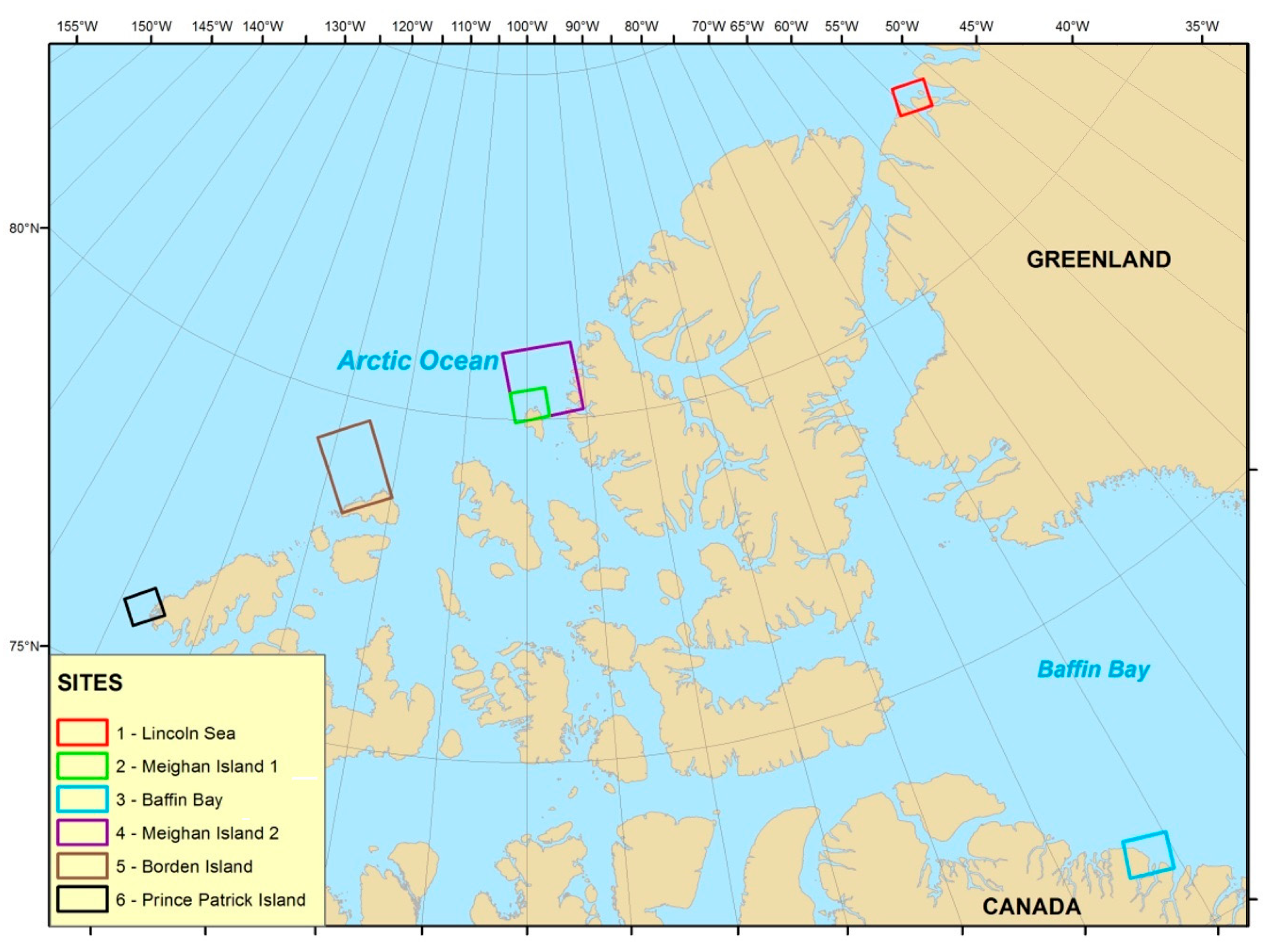
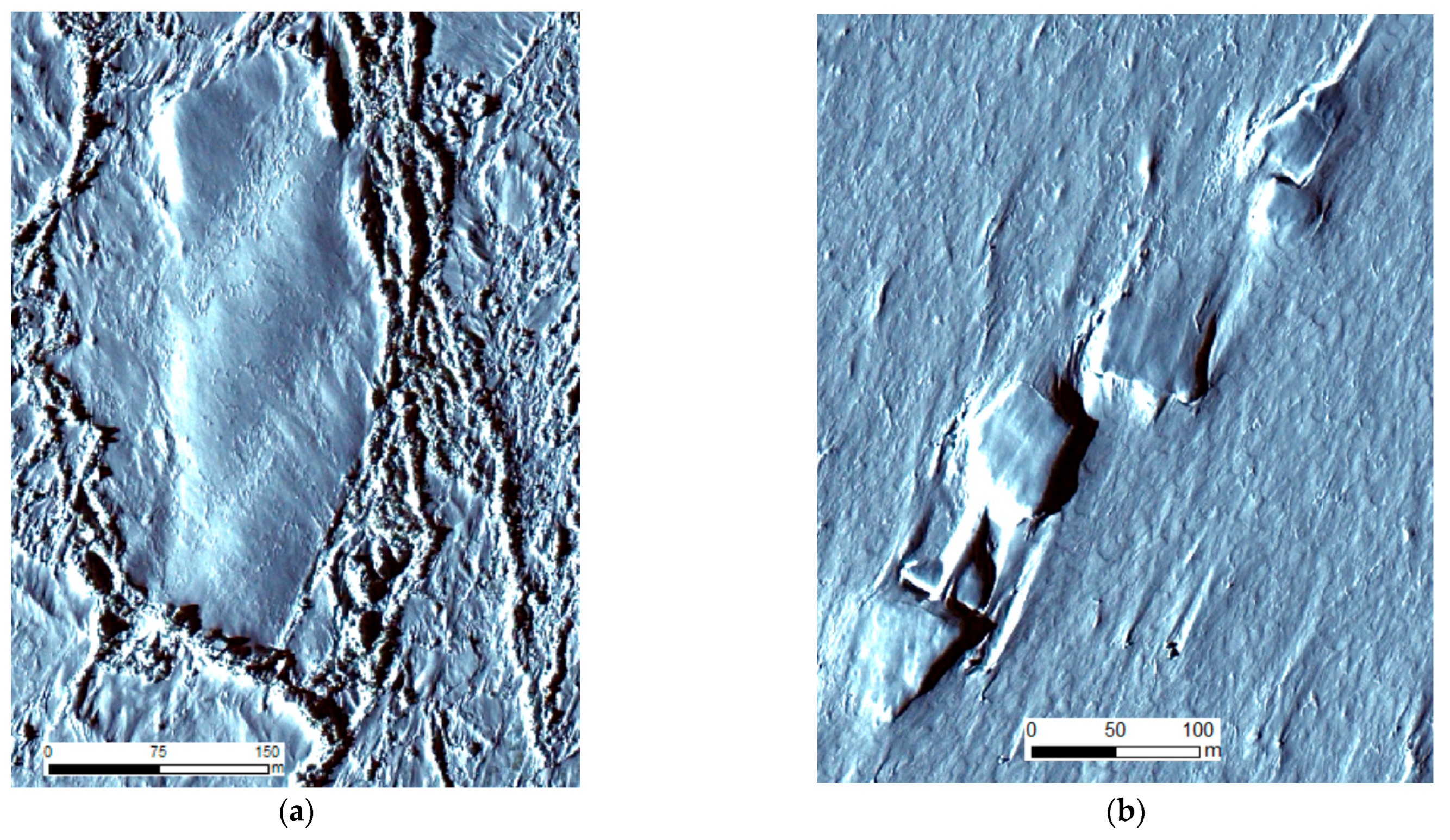


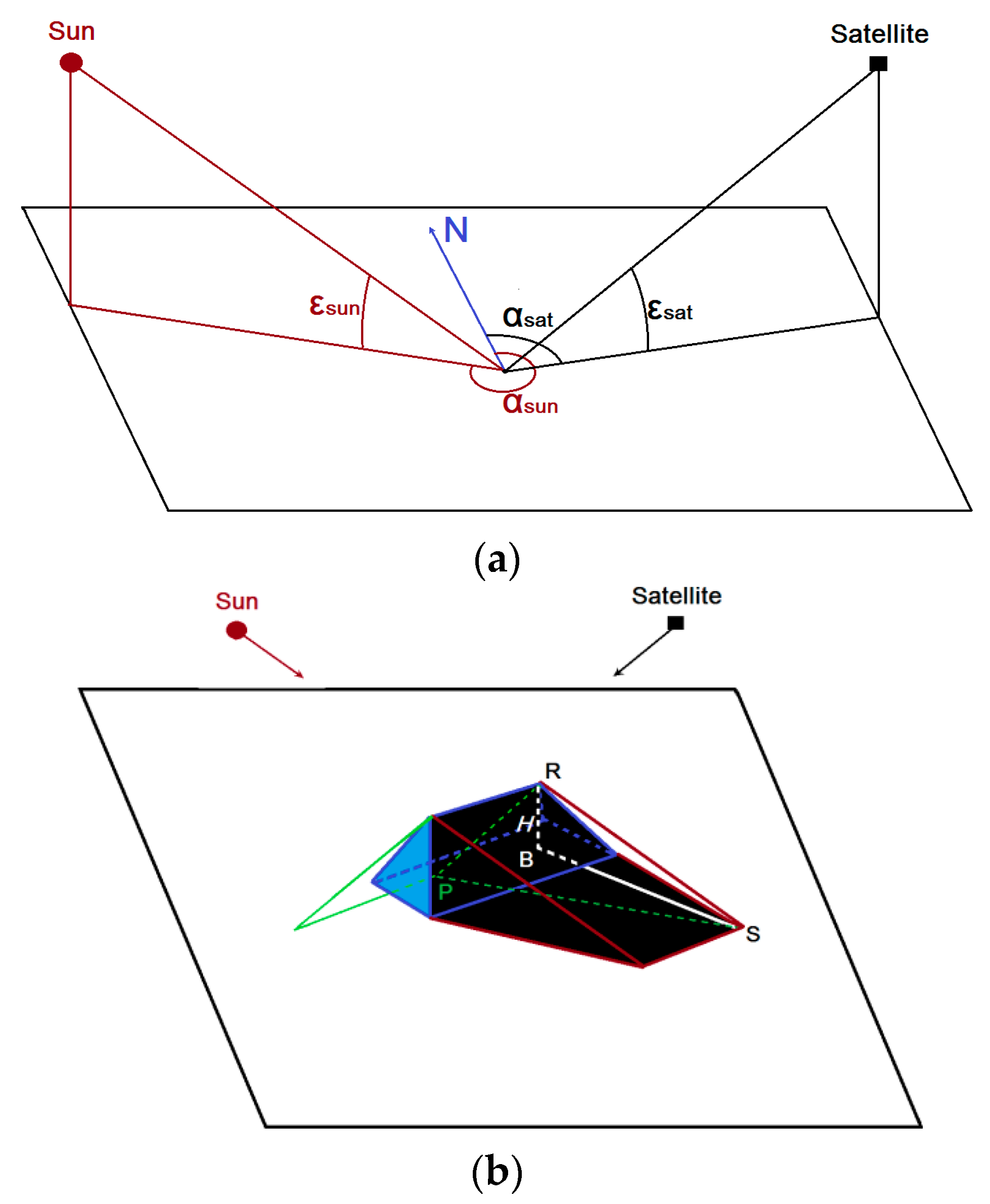





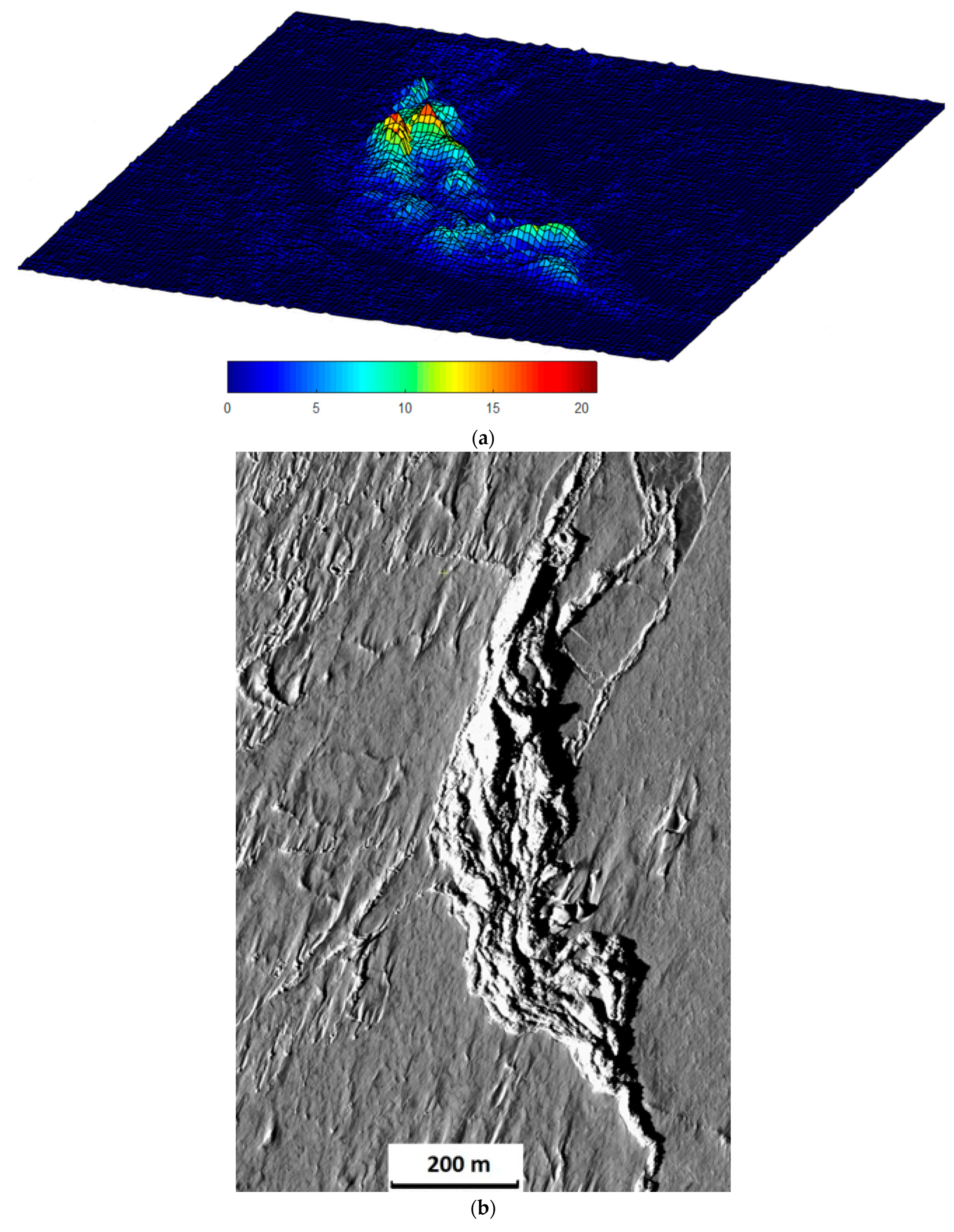
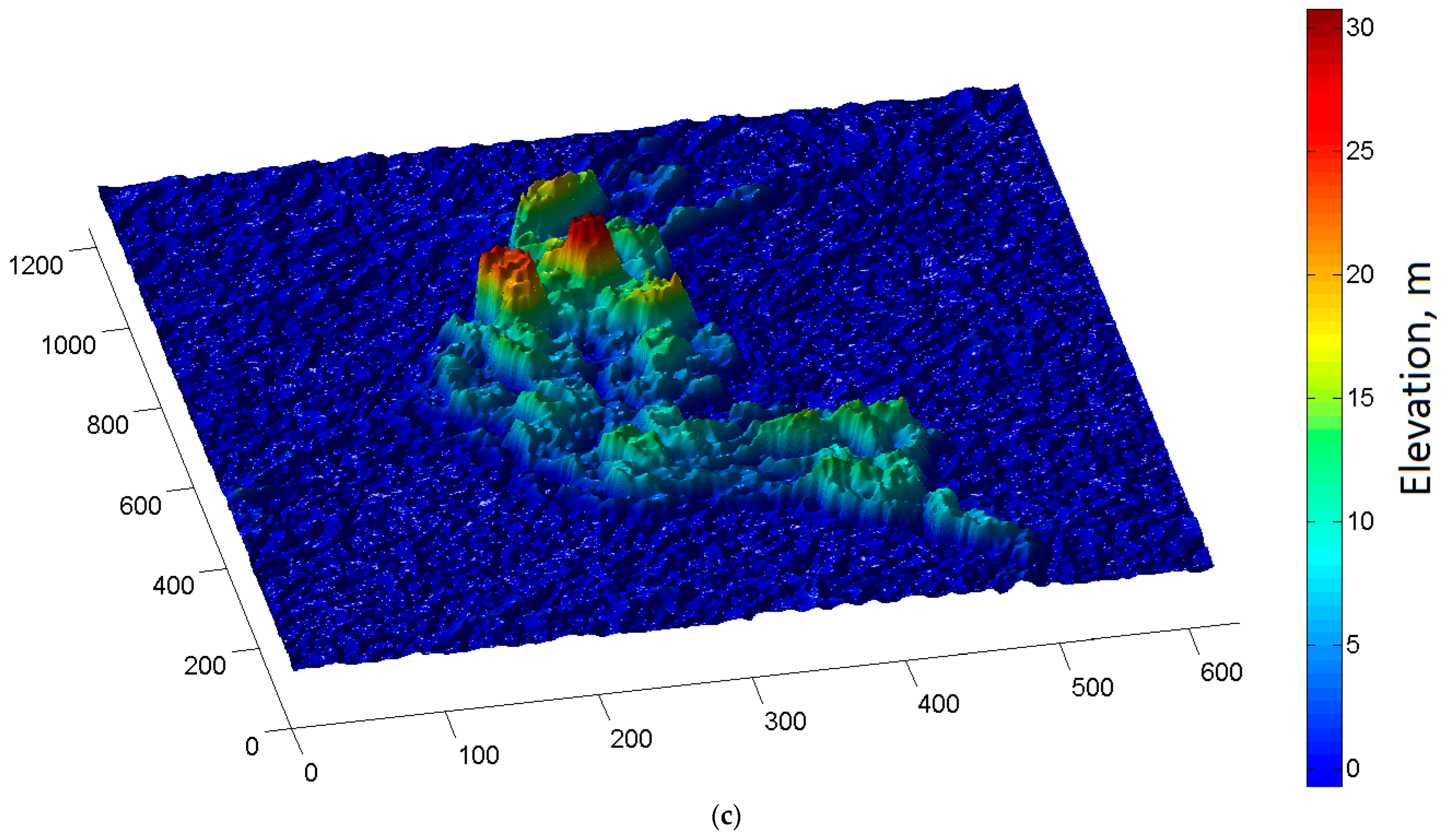


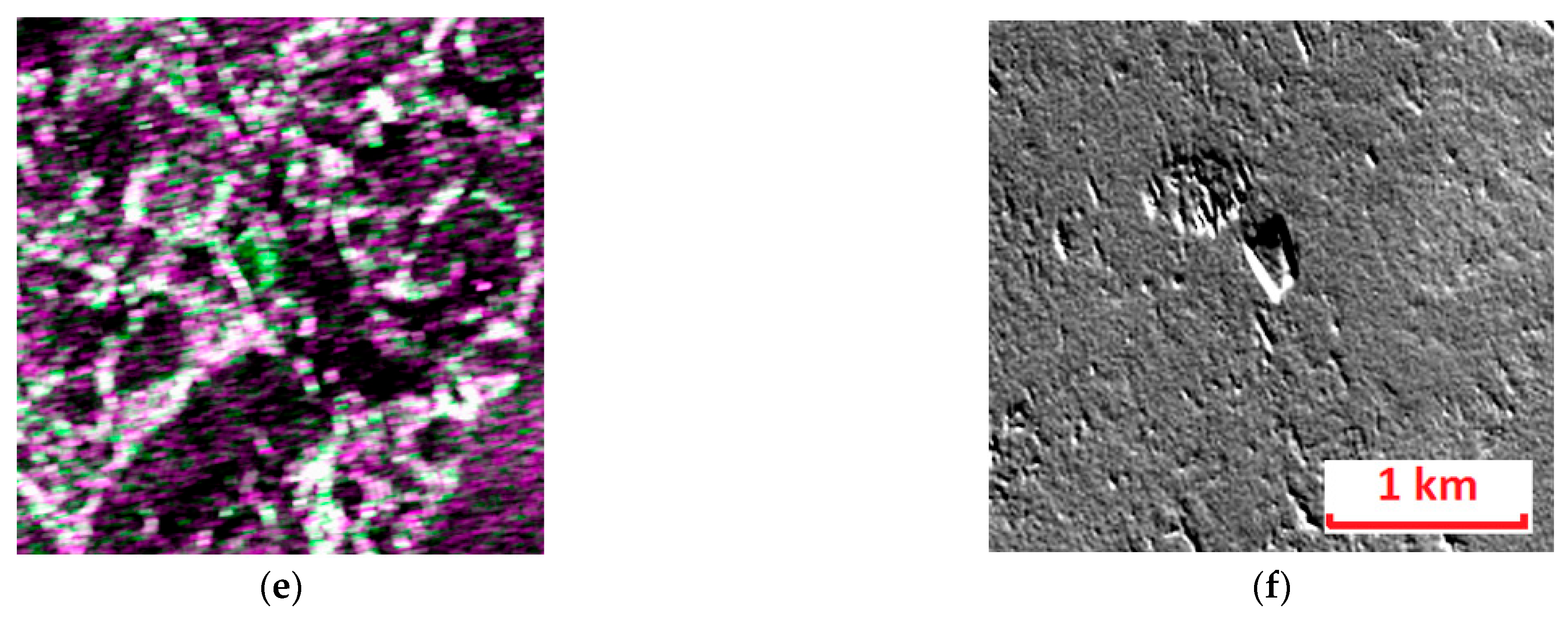


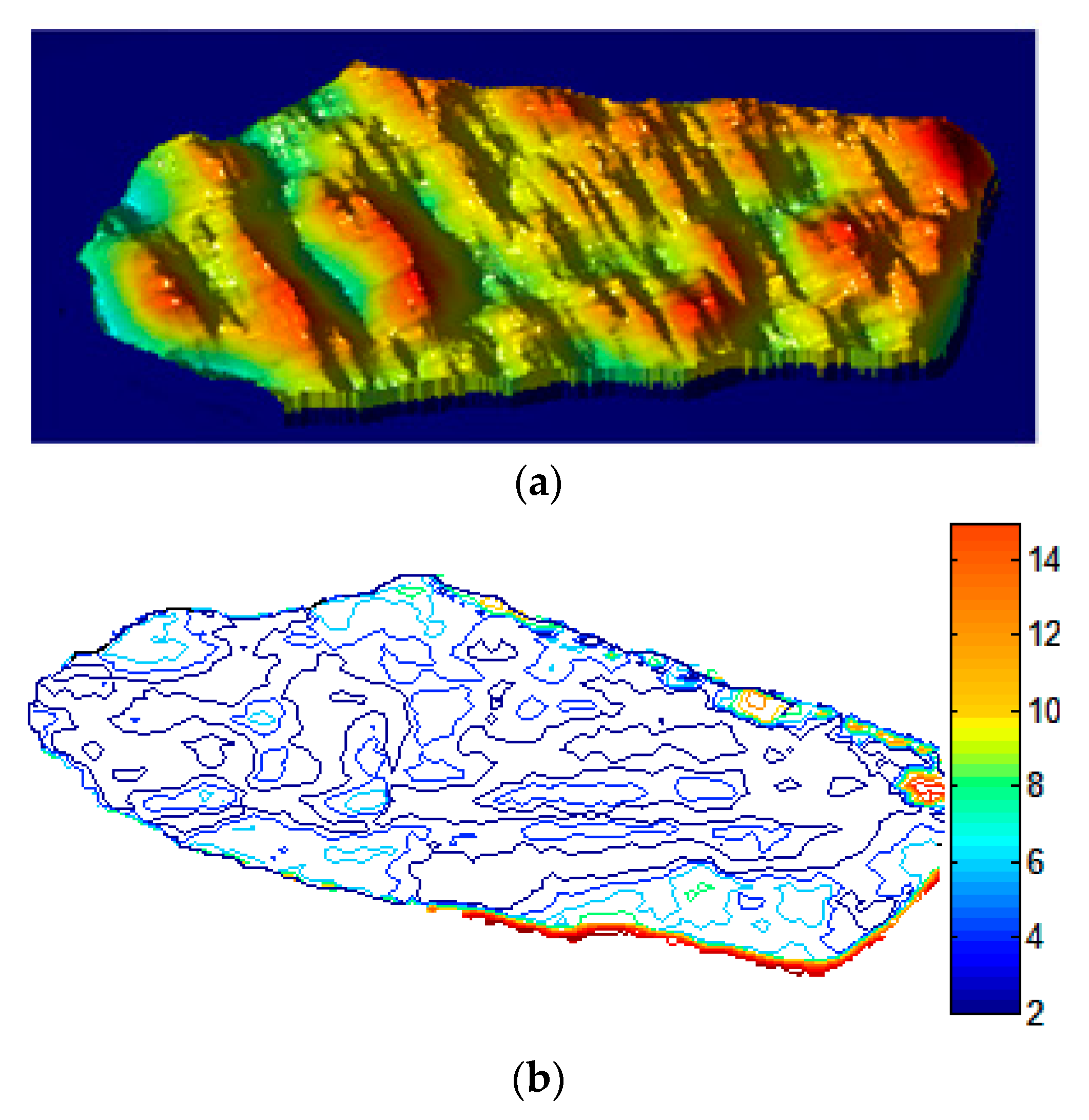
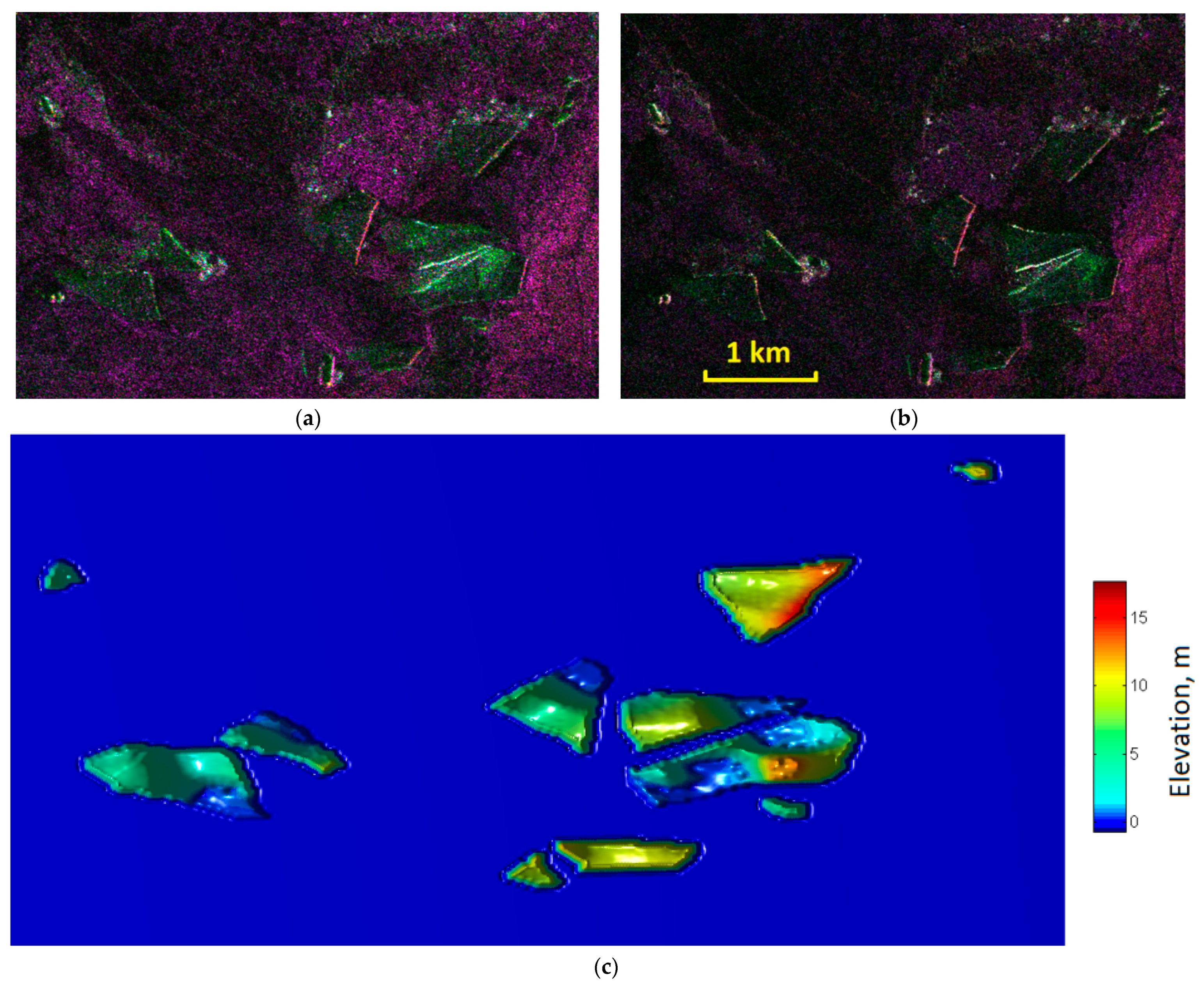
Disclaimer/Publisher’s Note: The statements, opinions and data contained in all publications are solely those of the individual author(s) and contributor(s) and not of MDPI and/or the editor(s). MDPI and/or the editor(s) disclaim responsibility for any injury to people or property resulting from any ideas, methods, instructions or products referred to in the content. |
© 2023 by the authors. Licensee MDPI, Basel, Switzerland. This article is an open access article distributed under the terms and conditions of the Creative Commons Attribution (CC BY) license (https://creativecommons.org/licenses/by/4.0/).
Share and Cite
Zakharov, I.; Bobby, P.; Power, D.; Warren, S.; Howell, M. Satellite-Based Identification and Characterization of Extreme Ice Features: Hummocks and Ice Islands. Remote Sens. 2023, 15, 4065. https://doi.org/10.3390/rs15164065
Zakharov I, Bobby P, Power D, Warren S, Howell M. Satellite-Based Identification and Characterization of Extreme Ice Features: Hummocks and Ice Islands. Remote Sensing. 2023; 15(16):4065. https://doi.org/10.3390/rs15164065
Chicago/Turabian StyleZakharov, Igor, Pradeep Bobby, Desmond Power, Sherry Warren, and Mark Howell. 2023. "Satellite-Based Identification and Characterization of Extreme Ice Features: Hummocks and Ice Islands" Remote Sensing 15, no. 16: 4065. https://doi.org/10.3390/rs15164065






